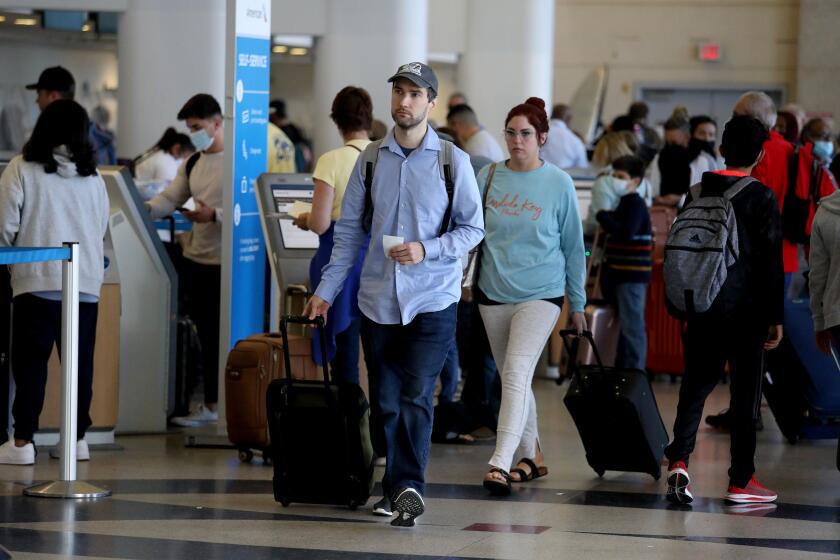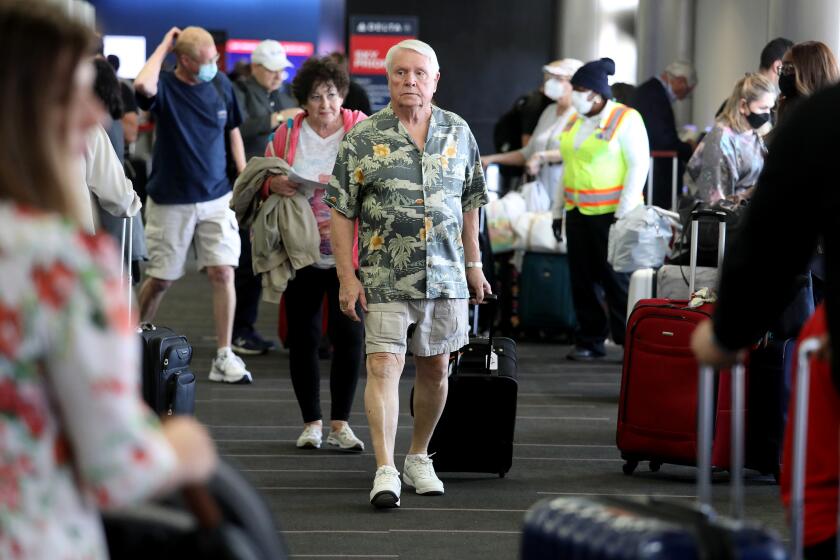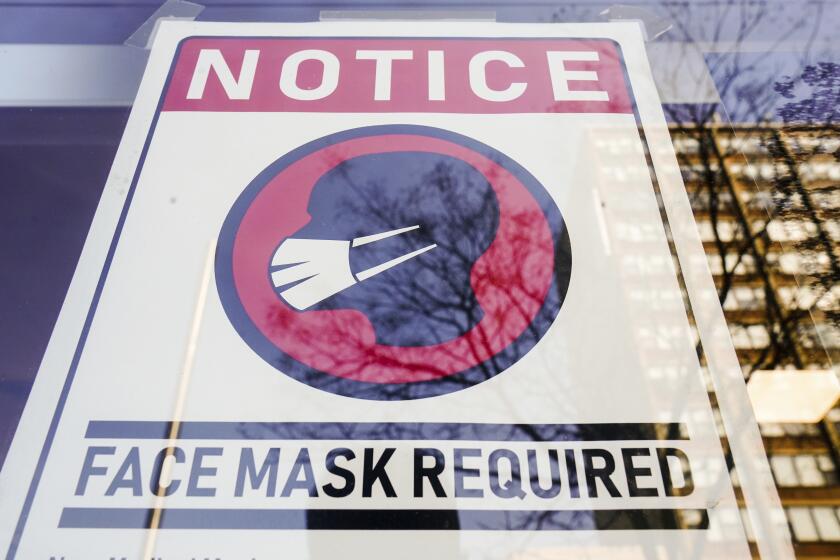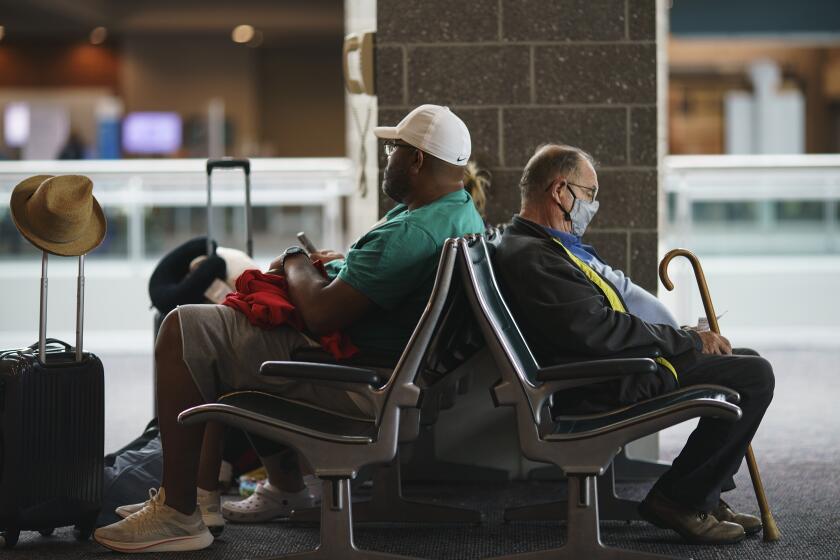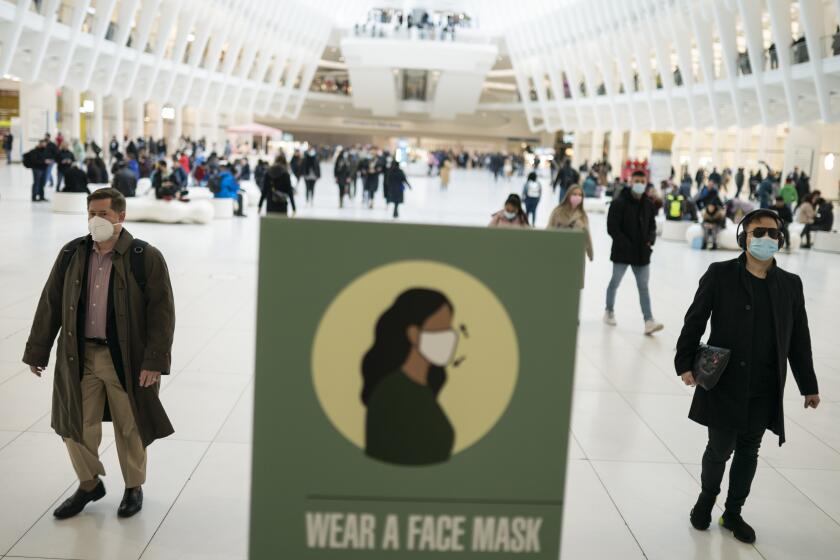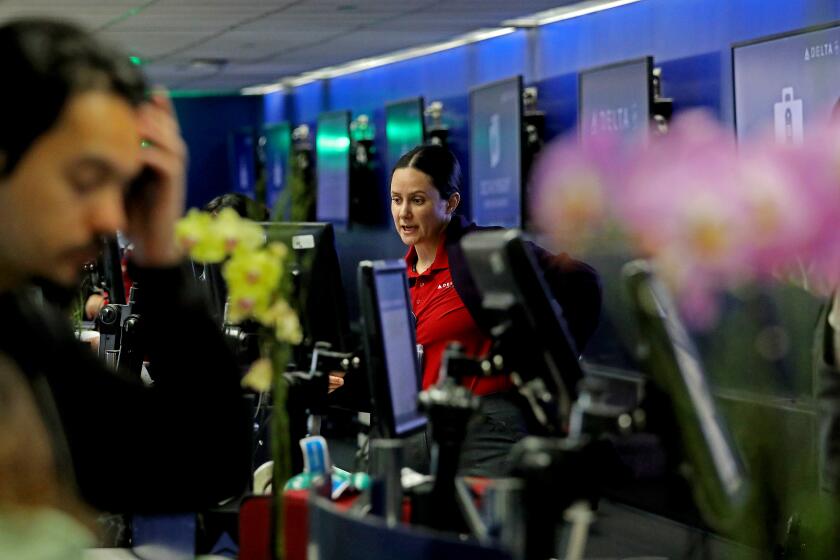Confused? Confounded? Why L.A. County is requiring masks again at airports and public transit
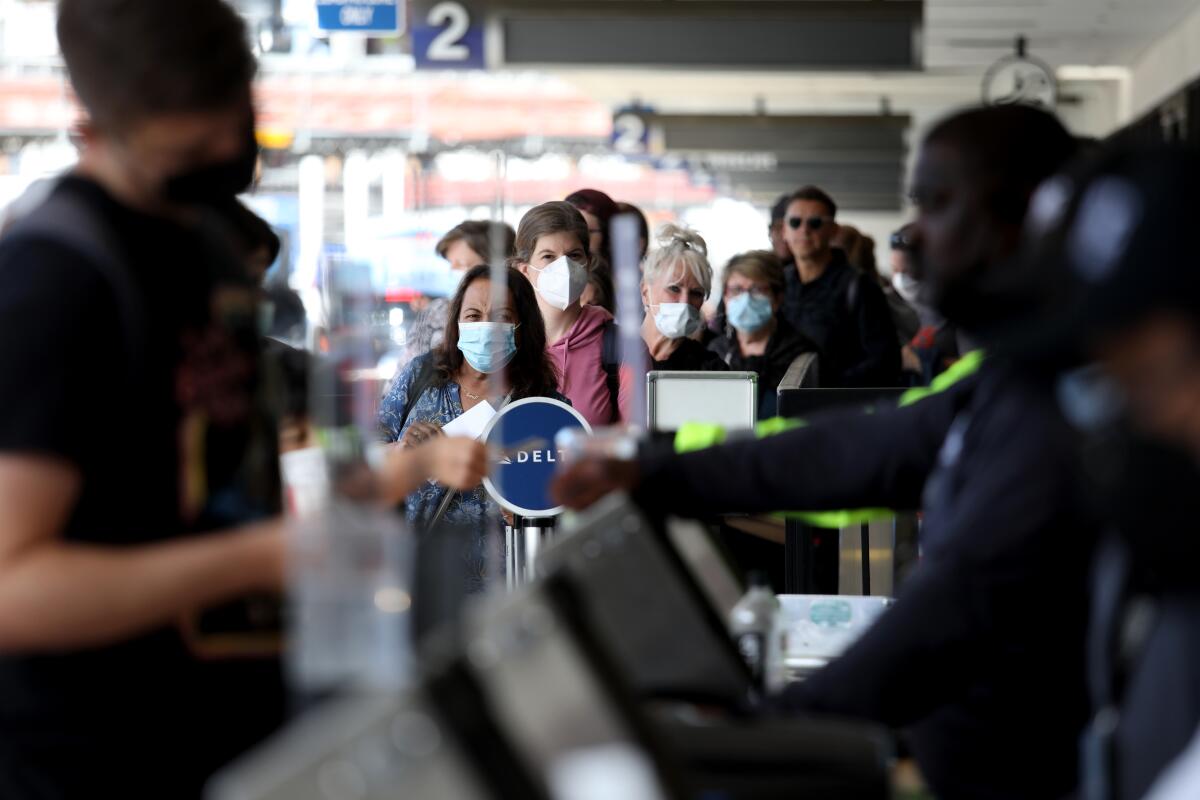
A new health officer order in Los Angeles County that went into effect today has the nation’s most populous county again enacting COVID-19 rules more stringent than the state’s or nation’s.
So why is L.A. County again requiring mask use at its airports and on public transit, including trains, buses, subway stations, taxis, Ubers and Lyfts?
On Monday, a federal judge in Florida voided the national mask mandate for airlines and other public transportation, saying the order exceeded the authority of U.S. health officials in their response to the COVID-19 pandemic. By Tuesday, most transit companies — including major airlines and ridesharing companies, as well as local agencies like the Metrolink commuter rail system and L.A. County’s Metro system — made masking optional.
But L.A. County’s Department of Public Health issued a new health order that reinstated a universal mask mandate at indoor airport settings and public transit.
Despite recent changes at the federal level, L.A. County continues to require travelers to mask up at airports and on public transit.
Here are several reasons why:
Coronavirus cases are rising in L.A. County
New coronavirus cases have doubled in the last month. Over the last week, L.A. County averaged 1,262 new cases a day, more than double the rate recorded a month ago.
The coronavirus test positivity rate also has increased to about 2% in recent days; two weeks ago, the rate was about 1%.
The latest case rate is equivalent to 87 cases a week for every 100,000 residents, meaning the county is seeing a substantial level of coronavirus transmission. L.A. County would need to drop to a rate of fewer than 50 cases a week for every 100,000 residents, or fewer than 730 cases a day, to return to a moderate level of transmission.
The increase is relatively modest, however. Experts say it isn’t clear whether the nation is headed toward a second Omicron surge that would challenge hospitals and dramatically worsen the daily COVID-19 death rate, as has happened to Britain, or if the U.S. could be spared a bad spring, as Spain has managed to.
Many experts stress that face coverings still protect against the coronavirus and that masking up makes sense — even if it’s no longer mandatory.
There’s concern about a new Omicron subvariant
Not only is there the rapidly spreading BA.2 subvariant of the Omicron variant in L.A. County, which now dominates sequenced coronavirus cases, there is also a newer subvariant called BA.2.12.1, which is believed to be 25% more contagious than its parent subvariant, BA.2.
The newer subvariant already accounts for more than half the new coronavirus cases in New York and New Jersey.
BA.2.12.1 has been detected in Los Angeles County, Public Health Director Barbara Ferrer said. Between March 27 and April 2, that subvariant accounted for 6% of analyzed cases in L.A. County.
New York state recently reported the first instance of significant spread of the coronavirus due to Omicron subvariants BA.2.12.1, and a related subvariant, BA.2.12. Officials there noted that their emergence “coincided with recent increases in COVID-19 cases observed in central New York.”
The trends in New York are worth watching. A number of counties in central New York now have a high COVID-19 community level, which reflects increased pressure on hospital systems. When counties reach a high COVID-19 community level, the CDC recommends the return of universal masking in indoor public spaces.
Philadelphia officials abruptly reverse course days after telling residents to resume mask wearing amid a sharp rise in coronavirus infections.
Transportation settings offer higher risk for infection
“Transportation settings are often crowded with limited and inadequate ventilation and deemed to be higher-risk settings for virus transmission,” Ferrer said. “Traveling on public conveyances increases a person’s risk of getting and spreading COVID-19 because it brings people in close contact with others often for long periods of time and often in crowded settings.”
In airports, one setting where masks may be particularly useful to guard against viral transmission is on the jetway as passengers wait to board the plane, where air circulation is generally not optimal.
Ferrer said this latest health order is not meant as a precursor to the reinstitution of broader mask mandates, such as in schools or other indoor public settings.
COVID-19 hospitalizations would have to worsen significantly for L.A. County health officials to seriously consider a wider return of indoor masking orders.
The CDC’s chief medical officer has advice for travelers looking to stay safe when people around them have ditched their masks.
The CDC thinks mask use on public transit is still a good idea
The U.S. Centers for Disease Control and Prevention had intended to keep the federal mask order on public transportation systems such as buses, trains and airplanes in place at least until May 3, pending further review of increasing coronavirus cases nationally.
But that timeline was upended by a federal court ruling in Florida striking down the mandate Monday.
In the hours and days after the ruling, airports and transit agencies across L.A. County said they would no longer enforce a mask mandate, citing the federal court decision and a statement from the Transportation Security Administration that it would no longer enforce the mask-wearing order.
Then, on Wednesday, the CDC reiterated that “at this time, an order requiring masking in the indoor transportation corridor remains necessary for the public health.” The Department of Justice has said it is appealing the court’s order.
“As soon as CDC determined that it was important to keep this masking requirement in place, we went ahead and aligned with the CDC,” Ferrer said.
The ruling abruptly halted one of the pandemic’s most hotly contested public health measures. Its implications may be long-lasting.
Universal mask-wearing is safer in higher-risk settings
Universal masking provides more optimal protection than in instances when only the wearer is trying to protect themselves from infection.
Masks are especially effective as a method of “source control” — a way to prevent someone who is contagious from spreading the virus, said Yifang Zhu, an aerosol scientist and professor in the department of environmental health sciences at the UCLA Fielding School of Public Health.
If you had only one mask for two people — one infected, one not — you would want to give it to the infected person, Zhu said.
“It’s better than nothing” for vulnerable people to wear masks when others go without them, she said, but “you are protecting others and the community as a whole if everybody just does a little extra effort.”
In settings where many other people are unmasked, those who do wear a mask — especially a respirator like a KF94, KN95 or N95 — are still getting a lot of protection, Ferrer said.
But such a situation is “certainly not as great [as] a situation as when everyone is wearing a well-fitting, high-filtration mask.”
Ferrer said keeping masks on “both gives you a lot of protection and protects other people from you potentially infecting them.”
Many medically vulnerable people are worried about how to handle public transportation now that a federal judge has struck down the CDC mask mandate.
Hospitalizations are low and stable. Why worry?
The number of coronavirus-positive hospitalizations remains at among its lowest of the entire pandemic. As of Wednesday, there were 224 coronavirus-positive patients hospitalized in L.A. County, just shy of the all-time low recorded about 10 months ago on June 12, when there were 212.
L.A. County came quite close to dipping lower than the record on Saturday, when there were 213 coronavirus-positive patients in the region’s hospitals.
The fact that hospitalizations haven’t yet risen may be because of the customary lag between an increase in cases and the resulting rise in hospitalizations. But it’s also possible, as Ferrer hopes, that “fewer infected individuals are requiring hospital care at this time, which suggests that vaccines and therapeutics are doing a great job preventing severe disease.”
Nationally, coronavirus-positive hospitalizations have started to rise. New daily coronavirus-positive hospitalizations have increased 8% over the prior week, although the numbers remain at their lowest levels since record-keeping began.
Also, there is evidence of transmission increasing in some situations. L.A. County health officials are noticing small increases in outbreaks at homeless shelters and work sites. Work settings with higher numbers of clusters of infections include those in the entertainment industry, grocery stores, factories and retail.
With the pandemic still in an unsettled state, Ferrer said the virus remains quite dangerous and unpredictable.
“We obviously have a very dangerous virus that still is in circulation that can really wreak havoc,” Ferrer said. “Because it has the ability to mutate, and in those mutations, we can get a variant that can be more destructive, more damaging, more devastating, we always are going to need to make sure that we’re being cautious and vigilant.”
Transmission is still considered substantial in L.A. County, and even though the latest variant in circulation may favor less severe illness, it still can result in significant illness in some, Ferrer said, including leading to long COVID, which can result in debilitating conditions that for some people have lasted years and from which they haven’t recovered.
In addition, “there’s still the … reality that, with lots of infections, you have a greater chance of having more variants crop up. And some of those variants could be more dangerous than the one we’re living with right now,” Ferrer said.
“We need to be prepared for the uncertainty of the future with an unpredictable virus,” she said.
More to Read
Sign up for Essential California
The most important California stories and recommendations in your inbox every morning.
You may occasionally receive promotional content from the Los Angeles Times.
